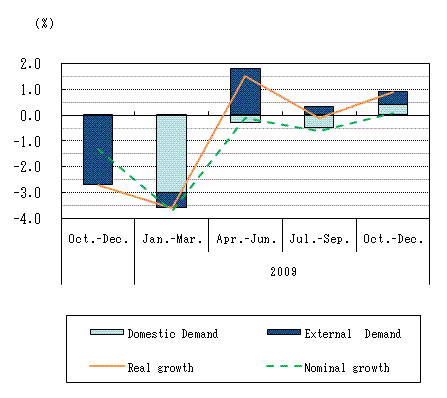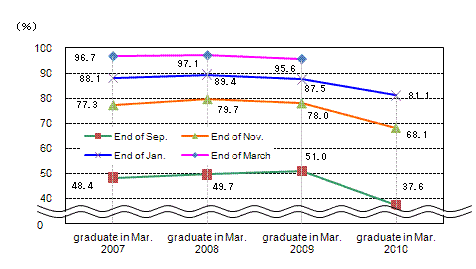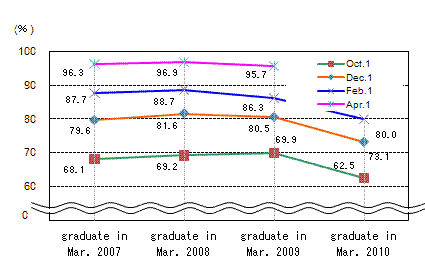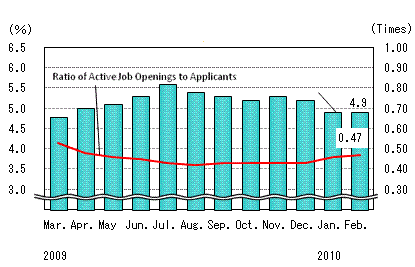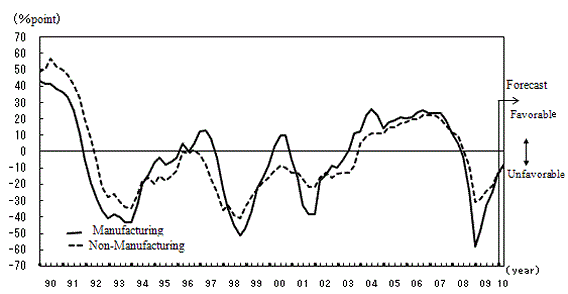Recent Statistical Survey Reports, March 2010
Statistical Survey Reports
Survey on Labor Economic Trend (February 2010)
Friday, March 5, released by the Ministry of Health, Labour and Welfare
By the judgment of employment surplus or shortage DI as of February 1, 2010, regarding the trend of the sense of employment surplus or shortage, in the total of industries surveyed, regular employees and part-time workers accounted for -5 (an increase by 3 points from the previous term), and the DI shows the excess of surplus. On the other hand, that of part-time workers accounted for +2 (a decrease by 1 points from the previous term).
Indexes of Business Conditions (Preliminary Report for January)
Tuesday, March 9, released by the Cabinet Office
The Coincident Index of Composite Index (CI, preliminary figures, 2005=100) in January was 99.9, an increase of 2.5 points, for 10 consecutive months. And 3 months backward moving average increased for 9 consecutive months, an increase of 1.97 points, and 7 months backward moving average increased for 6 consecutive months, an increase of 1.67 points. So the Assessment of Coincident Index was "Improving" again. The Leading Index was 97.1, an increase of 2.4 points, and the Lagging Index was 85.1, an increase of 2.2 points.
National Accounts (The 2nd Preliminary Estimates Oct.-Dec. 2009)
Thursday, March 11, released by the Cabinet Office![]()
Real GDP (Gross Domestic Product) growth rate (Seasonally Adjusted) was 0.9% (3.8% on annual basis), a decrease of 0.2 points (0.8 points on annual basis) from the 1st Preliminary estimates.
Of real GDP growth rate, 0.4% was contributed by domestic demand and 0.5% by external demand.
Quartely Estimates of GDP: Oct. ~Dec. 2009 (The 2nd Preliminary Estimates)
Growth rate of GDP from the previous Quarters(seasonally adjusted)
Contributions of Domestic Demand and External Demand to Changes in GDP
Survey on Situation of Preliminary Job Offers for New Graduate (Senior and Junior High School) (End of January, 2010)
Friday, March 12, released by the Ministry of Health, Labour and Welfare
The ratio of final-year senior high school students with preliminary job offers was 81.1%, a decrease of 6.4 points from the same period of the previous year.
The ratio of job openings to applicants for final-year senior high school students was 1.17, 0.55 points lower than the same period of the previous year.
The ratio of job openings to applicants for final-year junior high school students was 0.60, 0.37 points lower than the same period of the previous year.
Trend in the percentage of final-year high school students
with official job offer
Survey on Situation of Preliminary Job Offers for New Graduate in Mar.2010 (University, etc.) (February 1, 2010)
Friday, March 12, released by the Ministry of Health, Labour and Welfare
The ratio of final-year university students who got an official job offer to applicants was 80.0%, decreased by 6.3 points from the same period a year earlier.
That of final-year junior college students (female only) was 67.3%, decreased by 8.5 points from the same period a year earlier.
That of final-year technology college students (male only) was 97.3%, decreased by 1.7 points from the same period a year earlier.
That of final-year vocational school students was 72.4%, decreased by 6.4 points from the same period a year earlier.
Trend in the percentage of final-year university students
with official job offer
7th Longitudinal Survey of Adults in 21st Century (Continuous Survey on the livelihoods of the Japanese citizens)
Wednesday, March 17, released by the Ministry of Health, Labour and Welfare
As for the ratio of men who were aged 20-34 in 2002 and got married in these six years (2002-2008), by employment type, “regular (*)” accounted for 32.2%, “non-regular(*)” 17.2% and “unemployed” 16.6%.
(*)regular: regular employees,
Non-regular: non-regular employees; temporary worker, part-time worker, dispatched worker from temporary labour agency, contracts or entrusted employee and other
As for women who are age 20-34 in 2002 and got married in these six years(2002-2008), the change of their employment situations between before and after the marriage, “continuing the same job” for “regular” was 62.3%, “having left the job” was 27.5% and so on. On the other hand, for “non-regular”, “continuing the same job” was 42.5%, “having left the job” was 41.5% and so on.
As for married couples where children were born in these five years (2003-2008) and whose wife had been working as employees before she gave birth, the ratio of continuing the job of her after giving birth by employment type and existence utilizable childcare leave system, for “regular” “the system is available” was 81.0% and “the system is not available” was 42.1%. For “non-regular” “available” was 48.6% and “not available” was 21.3%.
Basic Survey on Human Resource Development (FY2009)
Tuesday, March 23, released by Ministry of Health, Labour and Welfare
68.5% of the companies surveyed implemented off-the-job training for the regular employees (77.0% in the previous fiscal year), 57.2% of them provided on-the-job training (59.6% in the previous fiscal year), and 66.5% of them provided support for self-development of workers (79.6% in the previous fiscal year). For all of them, the ratio decreased from the previous fiscal year. For non-regular employees, about 33.2% (39.6% in the previous fiscal year) of them implemented it, representing a lower level than for regular employees.
(*)A part of the results in FY2007 and FY2008 was recounted for connection with the results in FY2009.
Consumer Price Index (February)
Friday, March 26, released by the Ministry of Internal Affairs and Communications
The Consumer Price Index was 99.3, a decrease of 1.1% from the same month the year before, decreased for 13 consecutive months. Omitting Fresh food, the comprehensive index was 99.2, a decrease of 1.2% from the same month the year before, decreased for 12 consecutive months.
And in the ward -areas of Tokyo in March, the former accounted for 98.9, a decrease of 1.8% from the same month the year before. The latter accounted for 98.9, a decrease of 1.8% from the same month the year before.
Indices of Industrial Production (February)
Tuesday, March 30, released by the Ministry of Economy, Trade and Industry
The index of industrial production (seasonally adjusted) decreased by 0.9% from the previous month.
According to the Survey of Production Forecast in Manufacturing, Production is expected to increase in March and to decrease in April. The Synthetic judgment is “Industrial Production continues to show an upward movement.”
Family Income and Expenditure Survey (February)
Tuesday, March 30, released by the Ministry of Internal Affairs and Communications
The average monthly income for a worker's household with 2 or more family members was increased by 1.3% in real terms from the same month a year before.
With regard to the income contributing to increase - decrease rate, contribution of income earned by head of household accounted for 0.08 %, partner's income accounted for 0.17%, other household members' income accounted for -0.30% and non-current income accounted for 0.08%.
Labour Force Survey (February)
Tuesday, March 30, released by the Ministry of Internal Affairs and Communications
Report on Employment Service (February)
Tuesday, March 30, released by the Ministry of Health, Labour and Welfare
The unemployment rate (seasonally adjusted) was 4.9%, unchanged from the previous month. That for men was 5.2%, unchanged from the previous month, and that for women was 4.4%, decreased by 0.2 points from the previous month.
The number of unemployed persons increased by 250 thousand from a year earlier to 3.24 million.
The number of employees (seasonally adjusted) decreased by 150 thousand from the previous month to 54.74 million.
The ratio of active job openings to applicants (seasonally adjusted) was 0.47, increased by 0.01points from the previous month.
Trend in Unemployment Rate and Ratio of Active Job
Openings to Applicants
Monthly Survey on Service Industries (Preliminary Report in January)
Wednesday, March 31, released by the Ministry of
Internal Affairs and Communications
(PDF:74KB)![]()
The monthly sales amount of service industry in January 2010 was 20.4 trillion yen, a decrease of 8.0 % from the same month the year before. The total number of persons employed in the industry was 25.65 million, a decrease of 0.6% from the same month the year before. Among the service industry, the monthly sales amount of employment placement and worker dispatching business was 245.311 billion yen, a decrease of 21.7% from the same month the year before, and the number of persons employed totaled 224 thousand, a decrease of 15.0% from the same month the year before.
Monthly Labour Survey (Preliminary Report in February / Year-end bonus))
Wednesday, March 31, released by the Ministry of Health, Labour and Welfare
Total amount of cash earnings (for business establishments with 5 or more employees) decreased by 0.6% from a year earlier, and contractual cash earnings decreased by 0.3% from a year earlier.
Scheduled cash earnings decreased by 0.9% and non-scheduled cash earnings increased by 8.7% from a year earlier. Real wage (total) increased by 0.8% from a year earlier.
Non-scheduled hours worked by manufacturing industry workers at business establishments with 5 or more employees increased by 0.7% from the previous month (seasonally adjusted).
The amount of year-end bonus in 2009 (for business establishments with 5 or more employees) was 380,258yen, decreased by 9.3% from the previous year. The ratio of number of business establishments which paid year- end bonus was 70.6%, decreased by 2.7% from a year earlier.
TANKAN (Short-Term Economic Survey of Enterprises) (March)
Thursday, April 1, released by the Bank of Japan(PDF:190KB)![]()
The Diffusion Index (DI) (“Favorable”- “Unfavorable”) for business conditions in large enterprises of the manufacturing was -14 (-25 in the previous quarter and forecast -8 in the coming quarter), and the non-manufacturing DI was -14 (-21 in the previous quarter and forecast -10 in the coming quarter).
The Diffusion Index (DI) (“Excessive”- “Insufficient”) for employment conditions in large enterprises of all industries was 13 (15 in the previous quarter and forecast 9 in the coming quarter).
Business Sentiment(For Large Enterprise)
Other Reports
Monthly Economic Report (March)
Monday, March 15, released by the Cabinet Office![]()
Although the economy has been picking up steadily, it is only weakly self-sustaining and remains in a difficult situation such as a high unemployment rate. (In the previous month, “Although the economy has been picking up, it is short of autonomous factors and remains in a difficult situation such as a high unemployment rate”)
- Exports are increasing moderately. Industrial production is picking up. (The same as the previous month)
- Corporate profits are improving. Business investment is starting to level off. (In the previous month, “Corporate profits are decreasing substantially, but the downward pace has become moderate. Business investment is starting to level off, while weak movements are seen recently”)
- Although firms' judgment on current business conditions remains in a difficult situation, it continues to show movements of picking up as a whole. However, small and medium-sized enterprises are cautious about the immediate future. (The same as the previous month)
- While the employment situation remains severe,movements of an incipient recovery can be seen recently. (In the previous month, “The employment situation remains severe”)
- Private consumption is picking up. (In the previous month, “continues to show movements of picking up”)
- Recent price developments show that the Japanese economy is in a mild deflationary phase. (The same as the previous month)
Monthly Economic Labour Report (March)
Tuesday, March 16, released by the Ministry of Health, Labour and Welfare
In looking at the aspects of labor and economy, while the employment situation remains severe, movements of an incipient recovery can be seen recently. (In the previous month, “The employment situation remains severe”)
| To view PDF files, you will need Adobe Acrobat Reader Software installed on your computer.The Adobe Acrobat Reader can be downloaded from this banner. |

